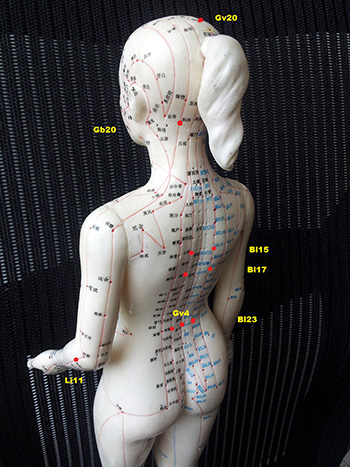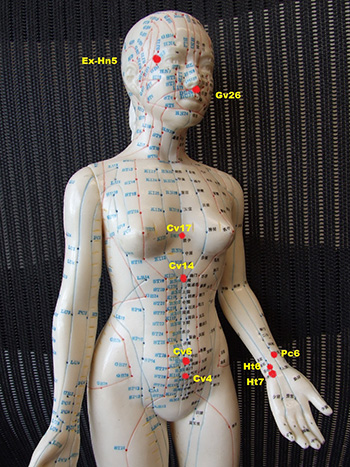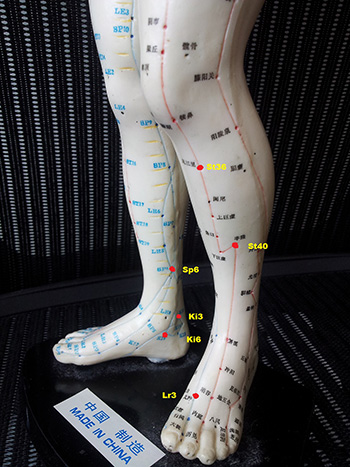Acupuncture and Moxibustion Therapies to Lower Blood Pressure
From a traditional Chinese medicine (TCM) viewpoint, hypertension development is associated with many factors and conditions, such as mental stress, improper diet, smoking, over drinking, and constitutional defects. They cause blood and qi (vital energy) disturbances, liver hyperactivity and metabolic pathogens such as phlegm and fire irritating the upper body. Among those with middle and late stage hypertension, their body often develop a disharmony of yin deficiency and yang hyperactive, and their liver and kidney systems are likely to be under functioning.
The cause and mechanism of hypertension are not well-known, but surely involve the heart, blood vessels, blood components, nerve system, endocrine glands and certain organs, as these are the integral parts of a complete blood circulation. Antihypertensive medications act on precise targets of the body to lower body pressure. For those who are poorly managed by antihypertensive medications, TCM can play a role in the treatment plan. TCM provides an integrated way of blood pressure control, it also helps protect the target organs and resolve some coexisting health problems concurrently. TCM management on hypertension has its unique advantages.
 |
Actions of antihypertensive medications
|
Acupuncture stimulates multiple levels, systems or targets of the body, which can bring blood pressure down through actions like expanding arteries, reducing heart pump, inducing urination and redirecting blood flow to the periphery body. In addition, acupuncture can change the body’s biochemical actions and neural message pathways, which rectify the chaos states of the brain and central nerve system, and promote the body to regulate the blood pressure more efficient. In TCM term, it soothes the meridians, unblocks collaterals, activates blood and qi, as a result, blood pressure can be stayed in a safe level constantly.
There are many acupoints for lowering blood pressure, commonly selected include da zhui (Gv 14), jian jing (Gb 21), fei shu (Bl 13), liang men (St 21), tai yang (Ex-Hn 5), feng chi (Gb 20), yong quan (Ki 1), san yin jiao (Sp 6), tai xi (Ki 3), tai chong (Lr 3), zu san li (St 36), qu chi (Li 11), zhong wan (Cv 12), feng long (St 40), bai hui (Gv 20), qi hai (Cv 6). During consultation, besides the blood pressure readings and medical history, TCM physicians will look into the specific disharmony pattern of the patients. Acupoint selections are also under the guideline of the meridian theory, therefore physicians will consider the affected meridian, the disharmony pattern and the disease type when designing a treatment plan. The individualized remedy will aim at regulating the whole body.
Below are acupuncture prescriptions for different types of hypertension:
Up-flaring liver fire
Therapeutic principle: acupoints are mainly selected along the liver, gall-bladder and kidney meridians, apply with reduction techniques.
Sample prescription: tai chong (Lr 3), tai yang (Ex-Hn 5), feng chi (Gb 20), tai xi (Ki 3)
Yin deficiency of liver and kidney
Therapeutic principle: acupoints are mainly selected along the kidney, liver and spleen meridians, apply with reinforcement techniques.
Sample prescription: tai xi (Ki 3), zhao hai (Ki 6), san yin jiao (Sp 6), tai chong (Lr 3)
Yin deficiency and yang hyperactive
Therapeutic principle: acupoints are mainly selected along the pericardium, kidney, spleen and liver meridians, apply with even techniques.
Sample prescription: feng chi (Gb 20), qu chi (Li 11), nei guan (Pc 6), tai chong (Lr 3), tai xi (Ki 3)
Liver-yang transforming into wind
Therapeutic principle: acupoints are mainly selected along the governor vessel, liver and pericardium meridians, apply with reduction techniques, if possible use pricking method (a TCM way of blood-letting).
Sample prescription: ren zhong (Gv 26), bai hui (Gv 20), nei guan (Pc 6), zu san li (St 36), tai chong (Lr 3)
Turbid phlegm accumulation
Therapeutic principle: selected acupoints are mainly along the triple burner, liver and stomach meridians, apply with even techniques.
Sample prescription: feng chi (Gb 20), feng long (St 40), zu san li (St 36), tai chong (Lr 3)
Blood stagnated internally
This type of hypertension usually occurs in the elderly and tends to accompany with atherosclerosis, cardiovascular or cerebrovascular problems. Physicians will select the back transport points and alarm points, and also the acupoints along the conception vessel, and heart meridians. Apply with reduction techniques, if necessary use blood-letting method too.
Sample prescription: xin shu (Bl 15), ge shu (Bl 17), ju que (Cv 14), nei guan (Pc 6), yin xi (Ht 6), tan zhong (Cv 17)
Deficiency of both yin and yang
This pattern usually occurs in the late stage of hypertension, physicians like to select the back transport points, and also the acupoints along the governor vessel, conception vessel, stomach and spleen meridians. Apply with reinforcement techniques, if necessary use moxa heating too.
Sample prescription: shen shu (Bl 23), ming men (Gv 4), qi hai (Cv 6), guan yuan (Cv 4), zu san li (St 36), san yin jiao (Sp 6)
Disharmony of governor vessel and conception vessel
This pattern usually occurs in the menopause women that often show a fluctuated blood pressure. Physicians will select the acupoints along the conception vessel, heart, liver, spleen and kidney meridians, apply with even techniques.
Sample prescription: qi hai (Cv 6), san yin jiao (Sp 6), tai chong (Lr 3), tai xi (Ki 3), shen men (Ht 7)
During needling insertions, stimulate on both sides until there are needling sensations, and then retain the needles for 20 to 30 minutes. At the beginning, acupuncture should be applied daily; ten times as one course. After two weeks, if the blood pressure improved and stabilized, then apply 2 to 3 times every week.
 |
1. Commonly used acupoints for hypertension
|
 |
2. Commonly Used acupoints for hypertension
|
 |
3. Commonly Used acupoints for hypertension
|
|